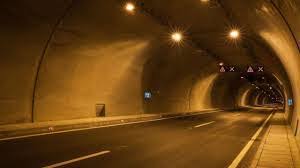Introduction to Chhattisgarh’s New National Highway Tunnel
Chhattisgarh has achieved a significant infrastructure milestone with the completion of its first-ever national highway tunnel. Stretching 2.79 kilometers, this tunnel is a crucial part of the Raipur-Vishakhapatnam economic corridor and promises to transform travel and commerce in the region by easing movement through the hilly terrain along the Kanker-Kondagaon border.
Details of the Tunnel Project
Die National Highways Authority of India (NHAI) successfully constructed the tunnel within 12 months, demonstrating remarkable engineering efficiency. This twin-tube design includes a left-hand tunnel that is expected to open for traffic by March-April 2026. The right-hand tunnel, currently still under excavation, is slated for completion by July-August of the same year. Together, they form a vital link on the 464-kilometer, six-lane NH-130CD highway.
| Feature | Details |
|---|---|
| Länge | 2.79 kilometers |
| Status (Left Tunnel) | Construction complete; operational by Mar-Apr 2026 |
| Status (Right Tunnel) | Excavation ongoing; open by Jul-Aug 2026 |
| Highway | NH-130CD (Raipur-Vishakhapatnam economic corridor) |
| Lanes | Six-lane highway |
Significance for Regional Connectivity and Trade
This tunnel cuts through hills that previously posed travel challenges, thus slashing travel time between Raipur and Visakhapatnam. Beyond convenience, it stands to be a catalyst for increased trade among Chhattisgarh, Odisha, and Andhra Pradesh, facilitating smoother movement of goods and people. Such enhanced connectivity often serves as a backbone for broader economic growth, boosting industrial activity and creating new opportunities for local communities.
Historical Context: Tunnel Engineering and National Infrastructure Growth
While tunneling may seem like a modern marvel, the history of tunnel construction dates back centuries with substantial evolution in techniques and scale. Early tunnels catered primarily to rail and water management, but the 20th century saw rapid advances in highway and urban transit tunnels worldwide. The introduction of innovative machinery and construction methods has enabled projects to be completed faster and safer, just like what was achieved in this Chhattisgarh project.
Internationally, tunnels play pivotal roles in connecting cities separated by challenging terrain such as mountains, rivers, or coastal barriers. For example, the San Francisco Bay Area features extensive underwater subway tunnels built with immersed-tube methods, while Europe boasts several Alpine rail and road tunnels that revolutionized cross-border transit. The engineering challenges faced in these projects—ranging from rock stability to water inflow control—reflect the global expertise harnessed to create secure and durable tunnels.
Types of Tunnel Construction Relevant to Highway Projects
- Drill and Blast Method: Often used in hard rock environments to carve out tunnels through hills and mountains.
- Shield Tunneling: A mechanized approach ideal for soft ground, commonly used in urban subway systems.
- Immersed Tube Tunnels: Prefabricated segments are sunk underwater or under rivers, useful for subaqueous crossings.
- Raise Boring and Glory-Hole Methods: Specialized techniques for shaft construction and excavation, enhancing safety and speed.
The success of the Chhattisgarh tunnel relied heavily on adapting techniques suitable for the local geologic conditions, ensuring safety and efficiency. Such projects not only enhance regional transportation but often become landmarks of civil engineering achievement.
Impact on Tourism and Economic Integration
The new tunnel will do more than just ease trade; it is projected to open avenues for increased tourism and socio-economic integration in the state. Improved infrastructure tends to attract visitors by providing better access to lesser-known destinations, including natural landscapes and cultural sites. While this particular highway tunnel is inland, improved road connectivity often encourages exploration of nearby lakes, gorges, and resorts where boating and sailing activities flourish.
For regions with water bodies or coastal access, seamless highway travel complements marine tourism by facilitating transport to marinas and yacht clubs. Though Chhattisgarh is landlocked, better connectivity can indirectly enhance access to nearby states with vibrant boating scenes, expanding opportunities for travelers looking to combine road and sea adventures.
Projected Benefits Summary
| Benefit | Description |
|---|---|
| Travel Time Reduction | Smooth passage through hills cuts down transit duration. |
| Trade Enhancement | Improves logistics for goods between Chhattisgarh, Odisha, and Andhra Pradesh. |
| Tourism Boost | Better road access paves way for increased visitor influx. |
| Economic Growth | Strengthens socio-economic integration and supports industrial development. |
Looking Ahead: The Role of Infrastructure in Regional Development
National highway tunnels like the one in Chhattisgarh are more than mere passages through mountains—they symbolize progress and connectivity. They help weave disparate regions into a cohesive economic fabric. As India continues to invest in its transport corridors, these projects underscore the importance of blending engineering innovation with regional planning.
In the broader context of international tourism and trade, such infrastructure projects often mark the beginning of new destination exposure and expanded economic zones. Though Chhattisgarh may not be a coastal hub for yachting or water-based leisure activities, the ripple effects of improved highways can facilitate wider regional access, supporting travel circuits that include water resorts and boating destinations reachable by road.
Summary and Conclusion
Chhattisgarh’s first national highway tunnel, situated along the NH-130CD highway on the Raipur-Vishakhapatnam economic corridor, represents a vital leap in the region’s transportation infrastructure. Bringing together cutting-edge tunnel engineering and strategic planning, it is set to reduce travel times, boost trade, and enhance socio-economic interactions across three states. The project holds promise for fostering tourism and laying the groundwork for sustained regional growth.
For travelers and locals interested in exploring water destinations or engaging in activities like sailing, boating, and yachting, efficient road connectivity remains key to reaching marinas, beaches, and lakes that complement the inland adventure. To access a wide selection of yachts, sailing boats, and charters suited for various tastes and budgets, the international marketplace at GetBoat.de offers unbeatable rental options, connecting land travel adventures with unforgettable water experiences.

 Chhattisgarh Unveils Landmark National Highway Tunnel on Raipur-Vishakhapatnam Corridor">
Chhattisgarh Unveils Landmark National Highway Tunnel on Raipur-Vishakhapatnam Corridor">
